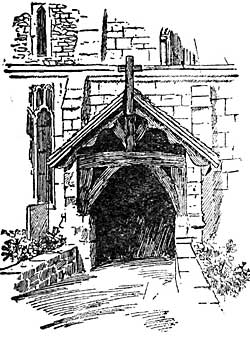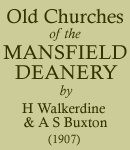< Previous | Contents | Next >
Hucknall Torkard

South porch.
THE church of Mary Magdalene, Hucknall Torkard, has undergone many changes since its Norman tower, the only relic of the early edifice, was built. In quite modern times it has been restored and enlarged almost beyond recognition. Prior to the 1874 restoration, we read that for years it had been in a ruinous condition and fast hastening to decay. Happily no such stigma now attaches to the building which, from the fact that it contains the remains of one of England's greatest poets is the mecca of the litterati from all climes. There is a strong disposition on the part of any writer dealing with the history of Hucknall church, to make Byron the central figure we should imagine, and seeing the pinnacle of fame he reached— Macauley wrote: At 24, Byron found himself on the highest pinnacle of fame with Scott, Wordsworth, Southey, and all the great and other distinguished writes beneath his feat— it is difficult not to allow the memory of "Childe Harolde " to predominate in this brief history. It is to Hucknall church that admirers of Byron's wonderful genius have come in numbers from America, to gaze upon the small slab let into the chancel floor on the south side, which marks his sepulchre. It was here that the Countess Guiccioli came to weep over the remains of him she loved so well, if report be true. And has not Washington, Irving, Moore, and a host of other celebrites wended their way to this sacred fane to do loving homage? An unusually vivid imagination is not required to conjure up the scene at Hucknall's village church on the Friday morning of July 16, 1824, when the cortege arrived from Nottingham bearing all that remained of the poet. Two constables and two bailiffs mounted, headed the mournful procession, followed by the undertaker. Then came James Orme, Esq., and twenty-six of Lord Rancliffe's tenants on horseback, two and two; a couple of mutes on horseback; a man with two supporters carrying a large plume of black feathers; four cloakmen on horseback; the State horse, richly caparisoned and led by two pages, the rider carrying on his arms the coronet of the deceased lord, on a crimson velvet cushion, ornamented with gold tassels and fringe; the hearse; mourning coach and six, with the urn containing the heart; coach and six containing Colonel Leigh, Colonel Wildman, Sir John Cam Hobhouse, and John Hanson, Esq. ; a coach containing the deceased's household; the Mayor of Nottingham, Alderman Loam, and Sheriffs Leavers and Guilford attended by three Corporation servants in another coach, whilst the Town Clerk Under Sheriff, and the rest of the deputation from the corporate body were in another coach and were attended by servants in full mourning. There were also the carriages of the Rt. Hon. Lord Rancliffe, William Sherbrooke, Esq.., Colonel Wildman (which contained the pall bearers), a chaise, a private carriage, and about forty gentlemen on horseback. It was 4 o'clock when the Rev. C. Nixon performed the last rites, and as the coffin was lowered into the vault the sobs of the dead lord's nearer friends and servants, especially of Fletcher, his valet are described as heartrending. Byron's journey to Greece to assist in establishing that country's independence, his unexpected death, the refusal of the authorities of Westminster Abbey to allow the remains to repose in the abbey are matters that scarcely come within the scope of this article, in fact, our enthusiasm for the poet's memory has caused us to transgress too far already. May we just add that he was laid to rest after a stormy career, in perhaps the very spot he himself would have chosen for on one side of his grave stands dear old Newstead, the &quo 30-May-2010 nnesley and its hills, the shrine of his heart's love. A more fitting sepulchre could not be chosen. The silver plate on the polished oak coffin covered with rich Genoa velvet, has the following inscription:—
The Right Hon.
George Gordon Noel Byron,
Lord Byron, of Rochdale,
Born in London, Jan. 22nd, 1788,
Died at Missolonghi,
In Western Greece,
April 19th, 1824.
An urn accompanied the coffin, and on it was inscribed:—
"Within this urn are deposited the heart, brain, &c., of the deceased Lord Byron."
The first of the Torcards to succeed Ofmand, and by their continuance left their name to distinguish the place, was Gaufr Torcard, who with the consent of Maud, this wife, and Henry, his son, for the health of his soul, and of his ancestors and successors, and for the soul of Alexander de Chiney, gave to God and the church of the Holy Trinity at Lenton, and the monks there serving God, one cart to be continually about to gather up his dead wood of Huckenale. There was a fine levied (10, Richard I.) between Gaufr Torcaz and Maud, his wife, Petents and William Pitie, Tenent, of two Knights' Fees in Huckenale and Lambcote, whereof they all gave the church of Hucken-hale and five bovats of land there to the church of Newstead. Ralf de Crumbwell and Avicia, his wife, made a certain causey, otherwise than had formerly been, to increase the water to serve their mill which was, it seems, in the ditch, and upon the soil which belonged to the Prior of Newstead, and extended from the churchyard to the head of the dam towards the cost for which they gave the said Prior three roods of land.
William, son of Coste according to the Testa de Nevil, held in Hukenhall the wainage of one carucat and certain effarts, and a certain mill, the whole valued at £6 10s., by the sergeancy of keeping the King's falcon. Much of the land came to the family of Grey, of Sandiacre, subsequently to John Leeke, Kt., who held the manor by Knight's service, and also by the service of carrying one gerfalcon from Michaelmas till Lent at the King's cost, with horses, and 2s. a day, and half a cistern of wine and two robes. John Biron and John Palmer purchased land of Francis Leek. Hugh de Annesley at one time held the manor and conveyed it to the Priory of Beauvale. To go back, we might mention that at the foundation of Newstead, Henry II. gave the church of Hockenhale to the monks, and we read that at the time the Prior of Newstead was patron it was worth £8. 'Tis now, writes Throsby, £4 18s. 1d., and Wm. Byron patron. At this period, the upper south window of the church contained the arms in glass of Grey of Sandiacre, and on the wall were the arms of the Byrons impaling Molyneaux. In the south window were also the arms of Bassett, of Drayton, Willoughby, of Wollaton, the Annesleys, and the Clifton's. The Curtis family, who once held one of the manors resided at hucknall for upwards of five hundred years, the last survivor of the family dying in July, 1777.
The rectory with the patronage of the vicarage, in the next year of Elizabeth's reign was granted to Edward Downinge and Peter Ashton. Eighteen years later the same Queen granted to Michael Stanhope, one of the grooms of the Priory chamber, and to Edward Stanhope, doctor in the laws, the manor of Hucknall Torkard, which belonged to Newstead, at the yearly value of £13 9s. 10d. Sir Michael Stanhope of Shelford, suffered death for his allegiance to the Protector, Somerset. Dr. Edward Stanhope was chancellor, both to the Archbishop of Canterbury and Bishop of London, and according to Thoroton, was one of her Majesty's High Court of Chancery.
Towards the close of the eighteenth century, the lordship contained about 300 acres, chiefly old enclosed land, the principal owners being the Duke of Portland, Mr. Lancelot Rolleston, Mr. John Newton, and others. The village contained about 200 dwellings, chiefly in a long street at the top of which stood the church with a tower and three bells, a nave, and side aisles. The church was described as being neat and clean.
Nearing the close of the 12th century, when the first of the Gothic styles superseded the Norman, the oldest part of Hucknall now remaining was built. Owing to restorations, rebuilding, and additions, little now remains as a guide in tracing out its subsequent history. The original church consisted of nave, chancel, tower, and north aisle, and of this the lower part of the tower, north arcade and some walling in the chancel still remain. The west window of the tower is three-light, with new intersecting tracery, but the head of the window is old. On the side of the tower above the aisle roof is a plain lancet window, and between the south aisle and the tower is another, once outside. The windows of the bell-ringers' chamber are two-light, divided by octagonal columns, and the window on the south side has a wheel sculptured over the head.
The tower, with its three plain chamfers, is supported by short columns having half round molds on their caps, and two half rolls on their bases. The north nave arcade has three bays with octagonal columns, the west respond is a corbel. The capitals are plainly molded and bridging the north aisle at its east end is an arch supported by a corbel on the east column. There is a half octagonal column on the north wall. The font is octagonal, quite plain, and standing on an octagonal stem.
In the fifteenth century the north aisle received attention, a pair of two-light windows being inserted, and a north door added. The latter is now blocked up. A feature of the church is the quaint 16th century porch, with its massive oak beams, rendered all the more striking from being the only wooden-fronted porch in the Deanery, and although common in some parts of England porches of this description are rare around Nottinghamshire. The beams are plain and unmolded, the sole ornament being a scalloped barge board. The belfry stage of the tower is debased with windows of two lights, built at a time when Gothic art was at a low ebb. Perhaps Hucknall is indebted to the 17th century for it, as these are in the style of Gothic windows frequently seen at that period. In the chancel is a three-seat sedilia, the arches ogee and trefoil headed, and possessing no hood molds. Built into the tower wall is the head of an incised slab, and two more are to be seen in the south wall of the south transept, one of which is curious, bear-part of a sword. The two latter slabs were found used as coping stones when making alterations to the church, and built into the present position for preservation.
